If you don’t have an organized freezer, it can be a challenge to find that bag of vegetables or locate a lasagna lodged in the depths of cold freezer. With the cost of food on the rise, getting your freezer organized can save you time and money and reduce the frustration of on overstuffed space.
An organize freezer is also the place where meal planning and healthy eating starts, so check out our step-by-step guide to organizing your freezer the right way.
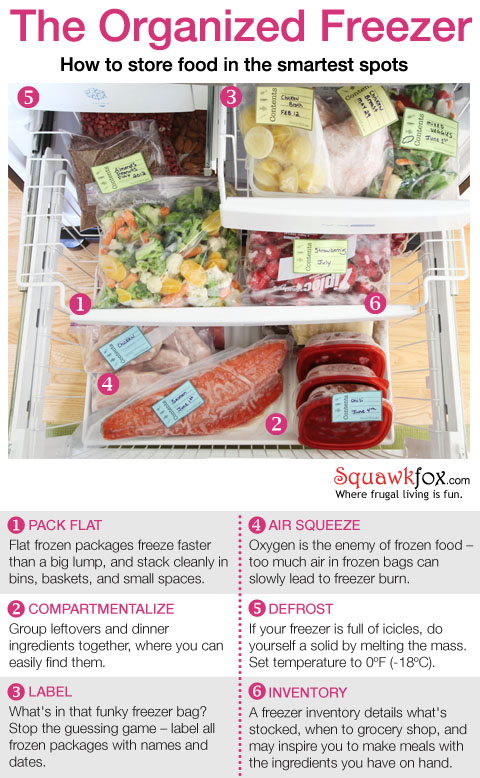
Our Project: Organize Refrigerator and Project: Organize Pantry hacks are simple and money-saving too! Now let’s get to Project: Organize Freezer!

An organized freezer free from frost and ice can also help you save money. See How to defrost your freezer for the guide. Bring a hairdryer!
Step One: Dump, Defrost, and Deal
When was the last time you dug into the depths of your freezer and dealt with the daunting items hiding in the dark? Spending good money to store undesirable, past best-before, or freezer burnt items is silly. So let’s do this.

Here’s how to get the freezer clean up done:
1. Deal: Remove everything from your deep or upright freezer. Scrutinize food for freezer burn, decades old expiry dates, and other undesirable qualities. The FDA has a handy freezer storage chart outlining suggested freezer storage times.
2. Compost: Some food just ain’t fit to keep. When freezer burn turns your food foul, you probably have to compost the compostibles or dump the dubious. Be sure to mark all your waste in a food waste diary — you don’t want to repurchase those items you didn’t eat in the first place.
3. Defrost: If your freezer is full of icicles, do yourself a solid by melting the mass. Check out Defrost your freezer and warm up to cool savings for the simple steps, and make your freezer space a more energy-efficient place.
 How to Defrost Your Freezer
How to Defrost Your Freezer
When your freezer is a time capsule celebrating the Ice Age, then maybe it’s time to join the Modern Age by thawing your deep freeze. Check out How to Defrost Your Freezer to get the job done.
Step Two: Pack Flat, Compartmentalize, Label
With a fresh freezer ready to rumble, here are a few strategies for packing your perishables safely away.
Pack it flat, compartmentalize.
Round, irregularly shaped objects are nearly impossible to keep organized in a freezer — you’ll end up stacking them oddly, with lots of wasted space in between. Flat packages are ideal since they can be stacked in a larger bin, on the freezer’s bottom, or they can be placed in a basket standing upright like file folders in a filing cabinet. Flat containers also tend to freeze faster than a big clumpy old lump of food.
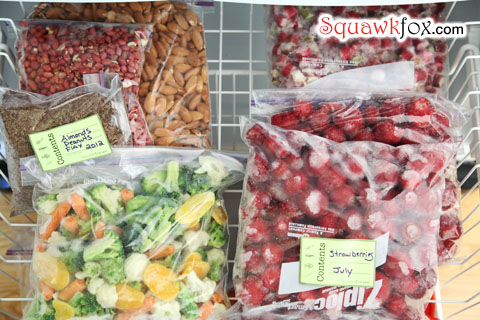
Newer freezers often come with a light storage system, including: baskets, bins, and drawers. Use them. Our chest freezer has two levels of hanging baskets, and these work well for separating meat, fruit, vegetables, and our homemade ice cream. Smaller baskets are ideal for items that would otherwise get lost in the shuffle.
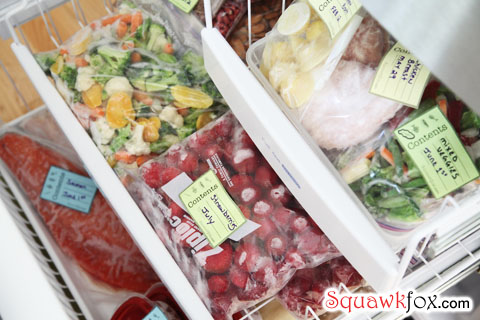
Do you need freezer bins? Before loading up your freezer bins, make sure you can still lift the lot. Lighter frozen foods are easier to move in top freezer shelving. Also, be wary of buying a new freezer with a massive storage system — too many bins can eat into your freezer space.
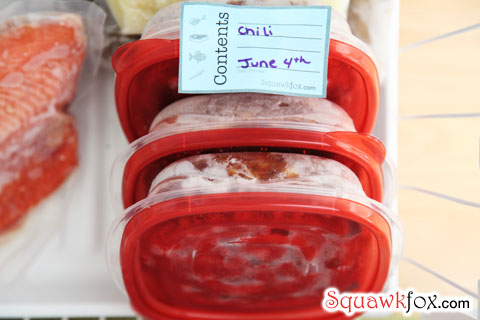
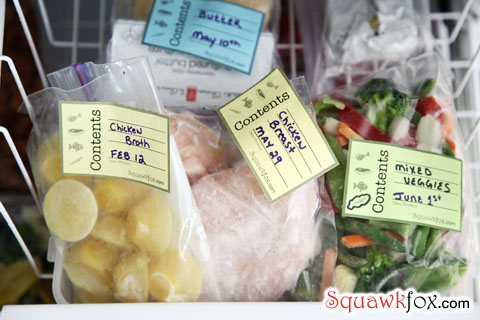
Always group your leftovers or freezer cooking ingredients together where you can find them. You’ll thank yourself when in a mad dash to get dinner done.
Keep the air out.
Are your freezer bags full of hot air? It’s time to deflate those balloons. Air is frozen food’s worst enemy — enough of the oxygenated stuff can slowly lead to freezer burn. See my post on freezer burn for more information.

To keep the frozen freeze out, be sure to double-bag your prepackage foods and remove all air from your freezer bags.
Label it.
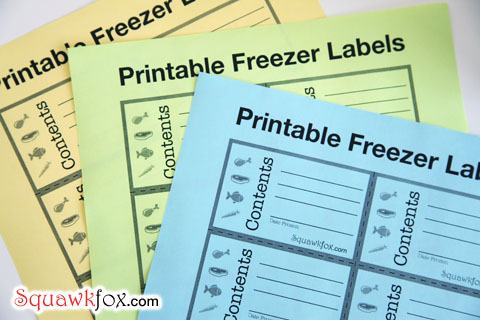
What’s in that funky freezer bag or container? Stop the guessing game already and either write on the packaging, or download my handy freezer labels.
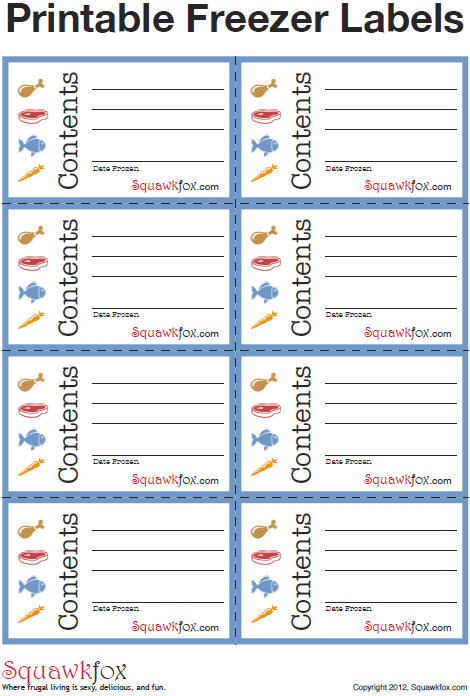
Free Download: Printable Freezer Labels (pdf)
Use permanent marker (washable markers will wipe off), print on bright paper, or use a special label paper to keep your food from getting lost in the shuffle.
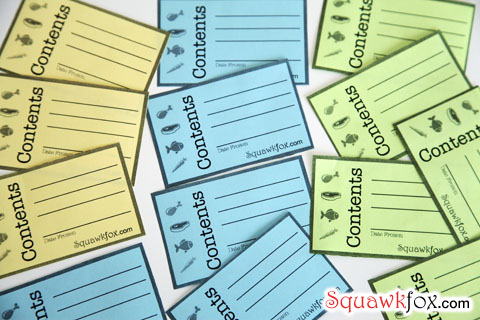
Cut out a stack and keep them handy in the kitchen or wherever you load your freezer. Easy.
Step Three: Make a Map
When you need to locate the frozen chicken somewhere in the mess of freezer burnt strawberries, packages of pot pies, and busted bags of veggies, you know it’s time for a plan of attack. Dinner needs to get done, and no one wants to go cave hunting in that disorganized space called your freezer.
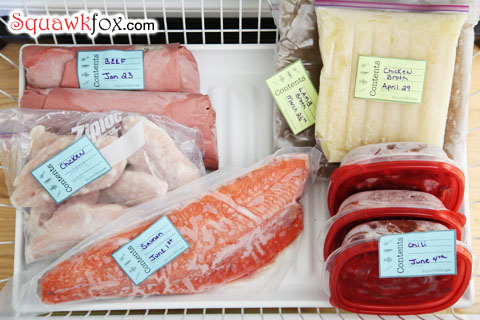
I hated the mess my husband made of our deep freeze, and he despised were I buried his bread. The only way to come to an agreement was to make a map.
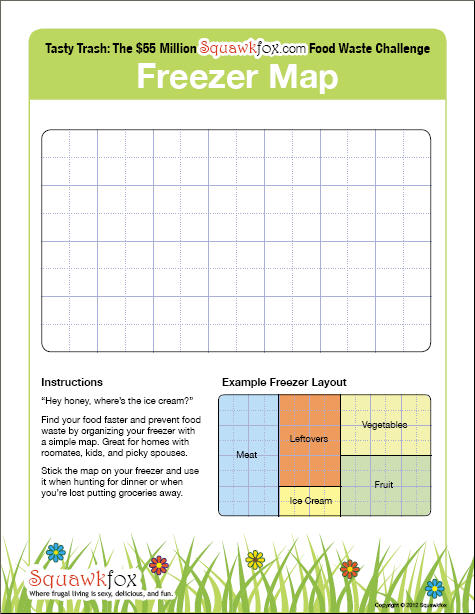
Free Download: Freezer Map (pdf)
I know you are totally giving me the side eye right now. A household map… for the freezer? Why yes. Perfect for homes with multiple roommates (everyone picks a section), and an argument ender when a spouse needs to search for (and locate) that last bag of broth. Freezer maps are also great for unpacking the groceries and keeping things tidy.
What goes where? I like to store meats in the far left quadrant, fruits and veggies on the far right, and my prepared leftovers right smack in the middle where I can see them. Ice cream and treats fare well in our top baskets. Your map is allowed to be different from mine.
So grab your spouse(s), roommate(s), or just tap into the analytical side of your brain and plan out your freezer space before jamming the lot back into the cold.
Team up your freezers: If you have a small freezer in your refrigerator and a larger chest freezer in the basement, get super organized by giving them separate roles. Use your smaller kitchen freezer for everyday food, such as: leftovers, ice cream, and smaller delicate items (like herbs) which can easily get lost in a larger deep freeze. Your larger freezer (perhaps located in the basement) can then play the role of storage for bulkier items.
Keep an Inventory
Now that your freezer is in tip-top shape with everything in the perfect place, it’s time to take inventory of what you have chillin’.
Why keep an inventory?
A freezer inventory details what you have stocked, tells you what needs to be added to your grocery shopping list, and may inspire you to make meals with the ingredients you have on hand.
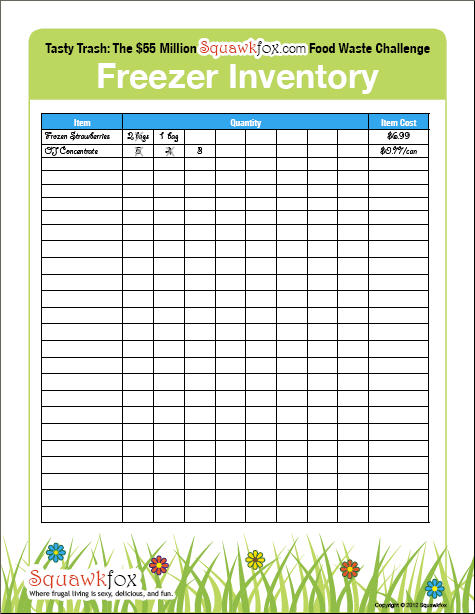
Free Download: Printable Freezer Inventory (pdf)
Keeping a freezer inventory can help with meal planning since you’ll know what’s in stock and what needs to be replenished. An up-to-date inventory can also make shopping less wasteful, saving you big money on your grocery budget. Who knows, maybe you can skip a supermarket trip!

Beginner’s Guide to Meal Planning
Save money. Save time. Save your sanity. Download our free 7-day printable meal planner to get better organized during your busy week.
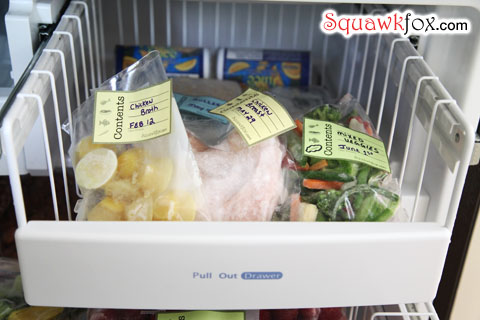
What to record:
1. Item: What’s in your freezer? List frozen meats, bagged vegetables, garden harvests, leftovers, your freezer cooking, and even soup broth.
2. Quantity: How much is in stock? Do you have enough leftovers for dinner? Quantity is an ongoing itemization of what you have in stock and what is about to run out. Make sure the kids update this column too!
3. Cost: You keep your grocery receipts, right? Go ahead and list the money spent on your food. It’s easiest to update when you’ve just done the groceries and restocked your freezer. This column can be a real eye-opener when you add up the total cost.

How to Organize Your Refridgerator
Save money by getting your fridge organized and storing items in the smartest spots.
Keep your food fresher, longer. Project: Organize Refrigerator
Love love love,
Kerry



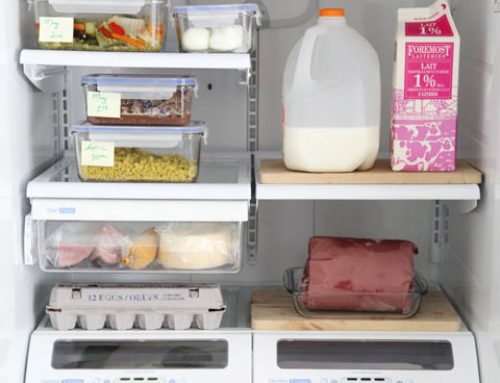
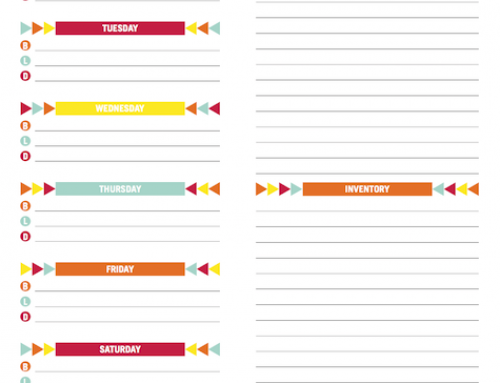
Another great post, Kerry! I totally agree with you about how important labelling is. I always tell my husband, “If you aren’t going to label that bag (with a date) you may as well just put it right into the garbage.” He loves that one – that’s what eye rolling means – right? ~ Robin
@Cecilie I keep my almonds, nuts, and seeds in the freezer to keep them fresh. 🙂
why do you keep almonds in your freezer? do they taste better? i just have them in a jar… thank you for a great site!!
I use self stick return address labels that I harvested from my junk mail to label my freezer items. I just write over them with a permanent marker.
We have a spare freezer in the garage. Every summer we have a month-long “eat down” of everything in the freezers from the last year. As we go, we pull everything out of the garage freezer and put in the kitchen one. That way, we can begin filling the garage one with stuff from this season’s harvest and current deals. We manage to eat up everything within it’s life-span this way. Nothing gets missed.
[…] to save money on food is not to throw it away. However, fresh food goes fast–but not if you use Squawkfox's ideas for having a freezer inventory of […]
You’re a genius! I’ve been trying to find a website like this for a long time. Finally, someone I kind of can relate too!
The flat packing makes sense for better use of space. Do you remove frozen vegetables from the bags they come in and repackage them in ziplock bags? Do they stay flat? Even small pieces like peas or corn?